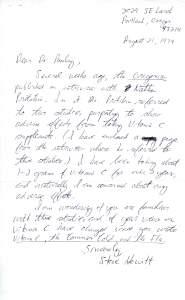
Letter to Pauling from Steve Hewitt, August 1979.
Dear Dr. Pauling. Several weeks ago, the Oregonian published an interview with Nathan Pritikin. In it, Mr. Pritikin referred to two studies purporting to show adverse effects from taking vitamin C….
In this letter from August 1979, a concerned follower of the nutrition advice given in Linus Pauling’s then recently published book, Vitamin C, the Common Cold, and the Flu, confesses that, while he is following the book’s advice and is megadosing on more than a gram of vitamin C supplements every day, he is concerned about adverse effects that might arise from the practice. What, he asks, does Dr. Pauling know of a collection of studies referenced by a Dr. Pritikin and reported on in the Oregonian? Has Dr. Pauling changed his mind about vitamin C?
Pauling replies to the man with his usual clarity:
…You ask about several statements made by Mr. Pritikin. I may say that these statements are just wrong. The reason probably is that Mr. Pritikin is ignorant about vitamins.
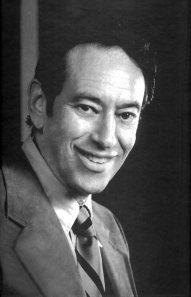
Nathan Pritikin
Nathan Pritikin was a dietician who, in the 1970s, found himself in competition with Linus Pauling for the health of America. An inventor involved in various scientific fields including chemistry, Pritikin was 40 years old when, in 1955, he was diagnosed with cardiac disease. Though a slender and fit-looking man, Pritikin’s cholesterol and blood pressure were through the roof. His doctors prescribed a series of medications and told him to rest up so as not to strain his heart.
Rather than following this advice, Pritikin began to read. Studying cultures both past and present from around the world, he concluded that heart disease (along with a variety of other degenerative diseases prevalent in the U.S.) could be fought, so long as one was armed with a proper diet and exercise program. Pritikin’s concept of a proper diet was one still followed by many today: low fat, low cholesterol, low sugar, plenty of complex carbohydrates and all the leafy greens and fresh fruit you could eat. The exercise regimen is also familiar: a moderate plan of preferably at least 30 minutes of aerobic activity per day.
For Pritikin, the diet and exercise worked. Within months his cholesterol was lower and he felt better; within a few years, his cardiac disease was a thing of the past. Equipped with the drive and instincts of a veteran inventor, Pritikin next did what came naturally – he invented a new diet and exercise plan for America and he took it to market. Starting with his “Pritikin Longevity Centers,” meant for those who suffered from degenerative diseases, and later moving to the written word, Pritikin became one of the health gurus of the 1970s and 80s, establishing himself alongside such names as Robert Atkins and Herman Tarnower, creators of the Atkins Diet and the Scarsdale Diet, respectively.
This was a space also occupied, of course, by Dr. Linus Pauling.
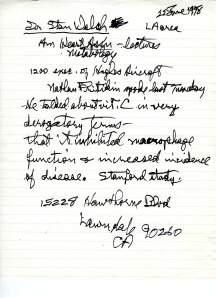
Pauling note to self, June 22, 1978.
Pauling had noticed Pritikin well before he received the letter detailing the Oregonian interview. In a letter from 1977 to Dr. Miles Robinson, a mutual friend of both Pauling and Pritikin, Pauling noted his awareness of Pritikin, his only criticism of the man and his health advice being that Pritikin “neglects his vitamins.” This is about as kind as Pauling would ever treat Pritikin in his correspondence.
The following year, it became apparent to Pauling that Pritikin was not only neglecting supplemental vitamins, but had begun to speak out against them, in particular vitamin C. During a lecture given in early 1978, Pritikin implied that high doses of vitamin C could inhibit certain actions of the body’s immune system, potentially making a person more ill. After composing a memo to himself on the subject, Pauling wrote to Pritikin, telling him that several people had been made upset by his attack on supplementary vitamin C and had written to Pauling about the lecture. Pauling had just completed a paper claiming the exact opposite, complete with 386 references, and he pointed out in no uncertain terms that Pritikin was obviously incorrect in his statements.
In his reply to Pauling’s letter, Pritikin did not bow to the pressure. Rather, he went on the offensive, accusing Pauling of promoting a diet high in fat and cholesterol, ignoring any connections that these habits might have to the development of atherosclerosis. “The public,” he said in his letter, “is led to believe that this type of diet is perfectly acceptable as long as high doses of vitamin C are ingested.”
In the letter, Pritikin also included a statement and a quote that he would repeat over and over in his books, interviews, lectures and letters. First, that humans had no need of supplements so long as they ate a diet that included vegetables and fruit. And second, according to D.L. Cooper, a doctor cited as serving on the 1972 Olympics medical board, “Americans excrete the most expensive urine in the world because it is loaded with so many vitamins,” a result of all the supplements that they ingest. Pauling answered the attack, naturally, writing that Pritikin’s referenced studies were wrong, and that the quote about excreted vitamins, specifically vitamin C, was also fictitious.
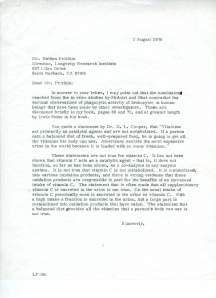
Letter from Pauling to Pritikin, August 1, 1978.
From his correspondence, we can ascertain that Pauling’s next interaction with Pritikin concerned the interview mentioned above in Northwest magazine, a Sunday insert in Portland’s Oregonian newspaper. In the interview, Pritikin was extremely derisive in his comments on vitamin C, even more so than at the lecture from the year prior. A few highlights:
Well, it’s completely wrong to take [vitamins]…For example, the most vitamin C you can hold in your body is about 20 or 25 milligrams a day. Anything over that just goes out through your urine….
If a woman is pregnant and is ready to deliver a child and she is on high vitamin C, both the mother and the child are set up to destroy vitamin C because the body can’t stand it. Now the child is born, but is not taking any new vitamin C, but the mechanism for destroying it continues for probably 10 to 15 days after you stop taking it, so on the fourth day the child goes into scurvy because its body is destroying vitamin C, but no new vitamins are coming in. Many cases are reported like that.
And, the most inflammatory, at least in the eyes of Pauling:
The bacteria count rises 100 times higher when you are on high vitamin C doses.
Thus, the more vitamin C you take, “the longer you’re going to be sick.” Reminded by the interviewer that this view was in direct opposition to Pauling’s stance, Pritikin retorted, “Well, he can make a statement, but this is what the study shows.”
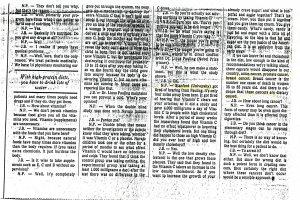
Excerpt from Pritikin’s interview in Northwest magazine, 1979.
Though Pritikin called Pauling out by name in the interview, Pauling didn’t reply to the salvo, at least not directly. In addition to calling Pritikin ignorant of vitamins in his reply to his follower, he ended his letter with, “I think it is quite wrong for Mr. Pritikin to talk about vitamins when he knows so little about the matter.” He also sent a copy of his response to Nathan Pritikin.
More exchanges occurred from there, including an one in which Pritikin, as reported to Pauling by a correspondent, quoted Art Robinson – who was suing the Linus Pauling Institute of Science and Medicine at the time – in saying that Pauling was sitting on evidence that vitamin C had the potential to cause and aggravate cancer. To that concerned reader, Pauling sent a copy of a letter that he had written to the editor of The Stanford Daily that listed all his reasons why Art Robinson was wrong.
Pritikin’s final attack on Pauling’s position came during a radio interview conducted on KGO-San Francisco’s Owen Spann talk show in October 1983. Pritikin appeared on the show to promote his newest book, The Pritikin Promise: 28 Days to a Longer, Healthier Life, and to clarify some of the diet advice presented within.
After asking his guest a few questions about the recent history of American heart disease, Spann launched into a discussion on vitamin C. And Pritikin, once again, turned to a study, saying “[Stanford University] got so sick of hearing Dr. Pauling say that vitamin C cleans out your arteries that they decided to see if it even does.” From there he described the study, stating that Stanford found that vitamin C raised LDL (bad cholesterol), while lowering HDL (good cholesterol). He finished with this bold statement: “If you want heart disease, take vitamin C.”
Upon hearing a recording of the interview, Pauling went in search of the Stanford study. Pauling’s notes documenting his search suggest that Pritikin was lying.
I telephoned Dr. Donald C. Harrison, professor of medicine and head of the cardiology department at Stanford. He says that he knows nothing about the study Mr. Pritiken [sic] said was made at Stanford, and so far as he knows Stanford has made no study of vitamin C in relation to heart disease.
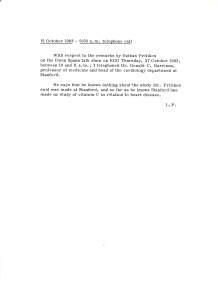
Pauling note to self, October 31, 1983.
The disagreement between Pauling and Pritikin ended with the Spann interview. Though no longer suffering from cardiac disease, Nathan Pritkin had battled leukemia for most of the 1980s. In February 1985, he took his own life. He was 70 years old.
